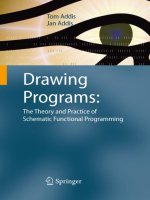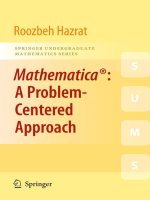IT training extension of mathematica system functionality aladjev 2015 06 05
Bạn đang xem bản rút gọn của tài liệu. Xem và tải ngay bản đầy đủ của tài liệu tại đây (2.33 MB, 390 trang )
VictorAladjev,VjacheslavVaganov
ExtensionofMathematicasystem
functionality
Tallinn–2015
ExtensionofMathematicasystemfunctionality:VictorAladjev,VjacheslavVaganov.–
Tallinn:TRGPress,563p.,2015
Systemsofcomputermathematicsfindmoreandmorebroadapplicationinanumberof
natural,economicalandsocialfields.Thesesystemsareratherimportanttoolsfor
scientists,teachers,researchersandengineers,verywellcombiningsymbolicalmethods
withadvancedcomputingmethods.Oneofleadersamongmeansofthisclassundoubtedly
istheMathematicasystem.Thebookfocusesononeimportantaspect–modular
programmingsupportedbyMathematica.Thegivenaspectisofparticularimportancenot
onlyforappendicesbutalsoaboveallitisquiteimportantinthecreationoftheuser
meansthatexpandthemostfrequentlyusedstandardmeansofthesystemand/oreliminate
itsshortcomings,orcomplementthenewfacilities.
Softwaretoolspresentedinthebookcontainanumberofratherusefulandeffective
methodsofproceduralandfunctionalprogramminginMathematicasystemthatextendthe
systemsoftwareandallowsometimesmuchmoreefficientlyandeasilytoprogramthe
objectsforvariouspurposesfirstofallwearingsystemcharacter.Theabovesoftware
toolsratheressentiallydilatetheMathematicafunctionalityandcanbeusefulenoughfor
programmingofmanyapplicationsaboveallofsystemcharacter.Furthermore,thebookis
providedwithfreewarepackageAVZ_Packagecontainingmorethan680procedures,
functions,globalvariablesandotherprogramobjects.Thepresentbookisorientedona
wideenoughrangeofusersofsystemsofthecomputermathematics,teachersand
studentsofuniversitiesatcoursesofcomputerscience,mathematicsandother
natural–sciencedisciplines.
Inthecourseofpreparationofthepresentbookthelicensereleases8÷10of
theMathematicasystemprovidedbyWolframResearchInc.havebeenused.
©VictorAladjev,VjacheslavVaganov.Allrightsreserved.PrintedbyCreateSpace,An
Amazon.comCompany
Contents
Preface5
Chapter1.AdditionalmeansininteractivemodeoftheMathematica13
Chapter2.AdditionaltoolsofprocessingofexpressionsintheMathematicasoftware26
Chapter3.Additionalmeansofprocessingofsymbolsandstringstructuresin
theMathematicasystem58
Chapter4.AdditionalmeansofprocessingofsequencesandlistsintheMathematica
software81
Chapter5.TheadditionalmeansexpandingthestandardMathematicafunctions,orits
softwareasawhole101
5.1.ThecontrolbranchingstructuresandcyclicstructuresintheMathematicasystem123
5.2.ThecycliccontrolstructuresoftheMathematicasystem127
Chapter6.ProblemsofproceduralprogrammingintheMathematicasoftware130
6.1.DefinitionofproceduresintheMathematicasoftware130
6.2.DefinitionoftheuserfunctionsandpurefunctionsinsoftwareoftheMathematica
system146
6.3.MeansoftestingofproceduresandfunctionsintheMathematicasoftware154
6.4.HeadingsofproceduresandfunctionsintheMathematicasystem182
6.5.Formalargumentsofproceduresandfunctions;themeansofprocessingthemin
theMathematicasoftware207
6.6.Localvariablesofmodulesandblocks;themeansofmanipulationbythemin
theMathematicasoftware235
6.7.Globalvariablesofmodulesandblocks;themeansof
manipulationbythemintheMathematicasoftware259
6.8.Attributes,optionsandvaluesbydefaultfortheargumentsoftheuserblocks,
functionsandmodules;additionalmeans
ofprocessingofthemintheMathematicasystem275
6.9.Someadditionalfacilitiesforoperatingwithblocks,functionsandmodulesin
theMathematicasoftware292
Chapter7.Meansofinput–outputoftheMathematica354
7.1.MeansoftheMathematicaforworkwithinternalfiles354
7.2.MeansoftheMathematicasystemforworkwithexternalfiles369
7.3.MeansoftheMathematicasystemforprocessingofattributesofdirectoriesand
datafiles385
7.4.Additionalmeansofprocessingofdatafilesanddirectories396
7.5.Certainspecialmeansofprocessingofdatafilesanddirectories420
Chapter8.ThemanipulationsorganizationwiththeuserpackagesintheMathematica
software431
8.1.Conceptofthecontext,anditsuseinthesoftwareofthe
Mathematicasystem432
8.1.1.InterconnectionofcontextsandpackagesinthesoftwareoftheMathematicasystem
437
8.2.Definitionoftheuserpackages,andtheirusageinthe
Mathematicasoftware440
8.3.AdditionalmeansofoperatingwithpackagesintheMathematica473
8.4.TheorganizationoftheusersoftwareintheMathematicasystem534
8.5.ApackagefortheMathematicasystem550
References553
Monographs,textbooksandbooksoncomputerscience,
theoryofgeneralstatistics,cellularautomatatheoryand
computermathematicssystems,preparedandpublishedbymembersoftheBaltic
Branchduring1995–2015558
AbouttheAuthors563Mathematica2,5÷10–trademarksofWolframResearchInc.
Preface
Systemsofcomputermathematics(SCM)findmoreandmorewideapplicationina
numberofnatural,economicalandsocialsciencessuchas:informatics,chemistry,
mathematics,physics,technologies,education,economics,sociology,etc.Suchsystems
asMathematica,Maple,REDUCE,MuPAD,Derive,Magma,Axiom,Maxima,GAP,
MathPiperandothersaremoreandmoredemandedforlearningofthemathematically
orienteddisciplines,invariousscientificresearchesandtechnologies.Thesesystemsare
themaintoolsforteachers,scientists,researchers,andengineers.Researchesonthebasis
oftechnologySCM,asarule,wellcombinealgebraicmethodswithadvancedcomputing
methods.InthissenseofSCM–interdisciplinaryareabetweeninformaticsand
mathematicsinwhichresearchesareconcentratedondevelopmentofalgorithmsfor
algebraical(symbolical)andnumericalcalculationsanddataprocessing,andoncreationof
programminglanguagesalongwithprogramenvironmentforrealizationofthiskindof
algorithmsandtasksofdifferentpurposewhicharebasedonthem.
Solutionofapplieduserproblemsinoneortheotherfieldofappendicesissupported
bypackagesofappliedprograms(PAPorsimplypackages)ofspecial,highlyspecialized
orgeneralpurpose.Classificationandcharacteristicofsuchclassofsoftwarecanbefound
inourpreviousbooks[3–5].Naturally,thequalifieduserwellowningoneofeffective
programminglanguages(forexample,Basic,C,Fortran,PL/1,Pascal,Lisp,Prolog,etc.)
inanumberofcasesforthesolutionofowntaskscanindependentlywriteanddebuga
separateprogramoracomplexofprogramsallowingtorealizealgorithmofitstasksona
personalcomputer.Insomecasessuchapproachcanbemoreeffective,thanuseforthese
purposesofreadysoftwaresincethesoftwaredeveloperatthesametimewellowns
specificsofthesolvedtaskandconditionsofitsoperation.However,suchapproach
demandsasaruleofseriouscostsandatpresentabundanceofvarioustypeandpurposeof
meansforapersonalcomputerbecomesconsiderablyinexpedient.Atthesametime,
developedPAParesuppliedwithownbuiltinprogramminglanguageofoneorotherlevel
ofcomplexityallowingtoprogramthewholetasksortheirseparatefragmentswhichmay
beintheenvironmentofapackageareinefficiently,inexpedient,andinsomecasesandis
impossibletorealizebythestandardmeansofapackage.
Thisbookisdevotedtotheclassofsoftwarecalledbysystemsofcomputermathematics
which,firstofall,areintendedforthesolutionofproblemsofmathematicalcharacter,
and,firstofall,toleadersinthisclasstosystemsMathematicaandMaple.Moreover,only
theindirectattentionconcerningcomparisonofsystemsoncertainseparatemomentsis
paidtothesecondsystemwhereasquitedevelopedtheircomparativeanalysiscanbe
foundinourbooks[28-30].Atthat,muchattentionwaspaidbothonexperiencewith
describedmeans,andfeaturesoftheirusage,andalsorecommendationsfortheuser
followingfromthem.Asfaraspossible,themosteffectivetechniqueofapplicationof
thesemeansforthesolutionofthoseorotherappliedusertaskshavebeenoffered.
Moreover,inbook[33]wepresentedanexcursusinhistoryofcomputeralgebrasystems
thatrepresentsacertaininterestfortheuserofthisclassofsoftware.Ratherdetailed
characteristicofthisseriesofbookscanbefound,inparticular,in[30-33]andinthe
presentbookisn’tconsidered.Ouroperatingexperiencewithsystemsofcomputeralgebra,
firstofall,MathematicaandMapleallowednotonlytocarryoutacomparativeanalysisof
thesemeans,torevealdeficienciesinherenttothem,andalsotocreateanumberofthe
meansexpandingtheirfunctionalityandeliminatingtheirsomedefects.Allthese
questionsincludingquestionsofterminologicalcharacterwithvariousextentofdetailing
havebeenconsideredinaseriesofourbooksandpapers[1-48].
TheMathematicasystemalongwiththeabove–mentionedMaplesystemisoneofthe
mostknownandpopularSCM,itcontainsaratherlargenumberoffunctionsforproviding
assymbolicaltransformations,andfornumericalcalculations.TheMathematicasystem
fortodayismultipurposemeansthatincludesalargenumberofopportunitiesforthe
solutionofquitewiderangeofproblems.Naturally,forthesemeanscan`tbegivena
ratherfullanalysiswithintheframeworkofthegivenbook.Furthermore,thetargetofthe
bookconsistsinother–inthebooktheattentionisfocusedonlyononeaspectofsystem–
opportunitiesofherprogramenvironmentforsolutionofspecialproblemsofmassand
systemcharacter.
Thisaspecthasthespecialimportancenotonlyforsolutionofappliedtasksbutaboveall
itisquiteimportantatcreationofthesoftwareexpandingoftenusedsystemmeansand/or
eliminatingtheirdefects,orsupplementingthesystemwithnewmeans.Inthiscontext
possibilitiesofbuilt–inlanguageofthesystemoncreationofsuchkindofproceduresor
functionsareofspecialinterest.So,programminginthesystemisamultifacetedsubject
andinitwefocusattentiononlyonquestionsofrealizationofprocedures/functionsthat
representmainprogramobjectsbothforthemostoftenusedmeansoftheuser,andforthe
meansexpandingandimprovingstandardsystemmeansinthesystemsoftware,i.e.
realizedbymeansofthebuilt–inlanguageofthesystem(Mathlanguage).Inthiscontextit
isalsopossibletoestimateinquitefullmeasuretheMathematicasystemsoftware,without
regardingtosomesubjectivemoments,firstofall,theuserpreferencesandhabits.
Naturally,thesemomentsplayaratheressentialpartfortheuserwhichhasacertain
experienceofworkwithprogramlanguagesofproceduraltypewhereasforabeginner
theystandnotsosharplybecauseoflackofsuchexperience.So,consideringorientation
ofthegivenbook,forconsciousacquaintancewithitscontentstheknowledge
ofMathlanguageatthelevelabovetheinitialissupposed,forexample,withintheworks
[29-33,51,52,55,57,60,62,64,66,71].Sincethe10thversionMath–languageiscalledas
WolframLanguagewhat,inouropinion,isresultofcertainpainfulambitionssimilarto
thosethatareassociatedwithbook”ANewKindofScience”alongwithafairshareof
self–advertisementofallegedlynewmeans.
ThegivenbookaffectsaratherextensivematerialonMathematicasoftwareinthecontext
ofitsopportunitiesinproceduralandfunctionalprogramming.Meanwhile,mainpurpose
ofthisbooklaidasidethequestionswhichareofinterest,firstofall,toreaderswhoarein
ownactivityatthefirststagesofanmasteringoftheMathematicasystem.Forbeginnersit
isrecommendedtoaddressoneselftothecorrespondingeditionswhoselistisrather
extensive,aboveall,theEnglish-language.TheMathematicasystemisconsideredandin
Russian–languageliterature,howeverEnglish–languageeditions,inouropinion,are
representedtousmorepreferable.Ingeneral,itispossibletofamiliarizeoneselfwith
literatureonthewebsitewww.wolfram.com/books,quiteusefulsourcescanbefoundinthe
representedreferences,includingaratherusefulreferencesintheInternet.
Thus,thegivenbookrepresentsacertainsetoftheselectedsystemproblemswhose
purposenotonlytoexpandormakemoreeffectivetheMathematicasystem,butalsoto
givecertainhelptothoseusersoftheMathematicawhowouldliketomovefromthe
user’sleveltoaleveloftheprogrammerortothosewhowhenusingMathematicaalready
facedsomeitsrestrictionsandwanttoimproveitsprogramenvironment.Atthat,the
skilledMathematicaprogrammersprobablywillalsobeabletofindforthemselvesinour
bookaratherusefulinformationandofappliedcharacter,andtoreflection.Therefore
illuminationonlyofsomequestionsessencewithouttheirratherdetaileddiscussion,
certainnuancesandconsiderationofadjacentquestionsthatareofteninterestingand
importantperseoftentakesplace.Moreover,thesystemmeanspresentedinthebookcan
beusedasratherusefulmeansatdevelopingownapplicationsintheenvironment
ofMathematica.Inouropinion,ananalysisofthesourcecodesofthemeanspresentedin
thisbookwhichusebotheffective,andnonstandardmethodsofprogrammingalongwith
quitecertainpracticalinterestwillallowtomastertheenvironmentofMathematica
systemmoredeeply.Forconvenienceoftheiruseinthegivenqualitythereaderhas
possibilityoffreedownloadofAVZ_PackagepackageforMathematicasystemof
versions8÷10whichcontainsthesemeans[48].Themeansconsideredthroughoutthe
presentbookanswerfullythemaingoaloftheofferedbookwhichcanbecharacterizedby
thefollowing2maindirections,namely:
(1)representationofanumberofusefulenoughmeansofsystemcharacterthatexpand
andsupplementstandardmeansoftheMathematicasystem;(2)illustrationontheir
exampleofreceptionsandmethods,enoughusefulinproceduralandfunctional
programming,alongwithanumberofessentialenoughfeaturesofthisparadigmof
programmingintheconditionsoftheprogramenvironmentoftheMathematicasystem.
Hereisquiteappropriatetonoteaquitenaturalmechanismofformationofownsoftware
meansoftheuserworkinginsomeprogramenvironment.Incourseofprogrammingof
oneorothermeans,orthewholeprojectacertainsituationisquiterealwhenisrather
expedienttoprogramsomeadditionaltoolsthatareabsentamongstandardmeans,either
theyaremoreeffective,ortheyaremoreconvenientthanstandardmeans.Inmany
importantcasestheapplicabilityofthesemeanscanhavemassenoughcharacter,allowing
toformprogramtoolkitofquitewiderangeofapplicability.
Exactlyinmanyrespectsthankstothedescribedmechanismwehavecreatedquitefamous
libraryUserLibforMaplealongwithpackageAVZ_PackageforMathematicawhich
containmorethan850and680meansrespectively[47,48].Allabove-mentionedmeansare
suppliedwithFreeWarelicenseandhaveopenprogramcode.Suchapproachto
programmingofmanyprojectsbothinMathematica,andinMaplealsosubstantially
promotedemergenceofanumberofsystemmeansfromabove–mentionedlibraryand
package,whendevelopmentofsoftwareforsimplificationofitsrealizationrevealed
expediencyofdefinitionofthenewaccompanyingtoolsofsystemcharacterthatarerather
frequentlyusedbothinappliedandinsystemprogramming.So,opennessof
theAVZ_Packagepackagecodeallowsbothtomodifythemeanscontaininginit,andto
programontheirbasisownmeans,ortousetheircomponentsinvariousappendices.In
ouropinion,tasksandmeansoftheirrealizationinMathematicawhicharepresentedin
theabovepackagecanberatherusefulatdeepermasteringofsystemandinanumberof
caseswillallowtosimplifyrathersignificantlyprogrammingofappendicesinit,firstof
all,thesystemproblems.Atthat,themethodologicalconsiderationsrepresentedinour
previousbooks[29-33]fullyremaininforceandrelativetothepresentbook.
MeansofAVZ_Packagepackagehavedifferentcomplexityoforganizationandused
algorithms;incertaincases,theyuseeffectiveandnonstandardreceptionsof
programminginMathematica.Thegivenmeanscanbeusedasindividually(forthe
decisionofvariousproblemsorforcreationontheirbasisofnewmeans),andinstructure
ofAVZ_PackagepackageextendingstandardtoolsoftheMathematica,eliminatinga
numberofitsdefectsandmistakes,raisingitscompatibilityrelativelytoitsreleasesand
raisingeffectivenessofprogrammingofproblemsinMathematica.Atoolrepresentedin
thebookissuppliedwithdescriptionandexplanations,containsthesourcecodeandthe
moretypicalexamplesofitsapplication.Asrequired,adescriptionhassuppliedby
necessaryconsiderations,concerningpeculiaritiesofprogramexecutionin
theMathematicaenvironment.
Thegivenbookconsiderscertainprincipalquestionsofprocedure–functional
programminginMathematica,notonlyforthedecisionofvariousappliedproblems,but,
firstofall,forcreationofthesoftwareexpandingfrequentlyusedfacilitiesofthesystem
and/oreliminatingtheirdefectsorexpandingthesystemwithnewfacilities.Thesoftware
presentedinthisbookcontainsaseriesofusefulandeffectivereceptionsofprogramming
inMathematicasystem,andextendsitssoftwarewhichenablesmoresimplyand
effectivelytoprogrammeinthesystemMathematicatheproblemsofvariouspurpose.The
representedmonograph,ismostlyforpeoplewhowantthemoredeepunderstandingin
theMathematicaprogramming,andparticularlythoseMathematicauserswhowouldlike
tomakeatransitionfromtheusertoaprogrammer,orperhapsthosewhoalreadyhave
certainlimitedexperienceinMathematicaprogrammingbutwanttoimprovetheir
possibilitiesinthesystem.WhereastheexpertMathematicaprogrammerswillalso
probablyfindanusefulenoughinformationforyourself.
Atthat,itshouldbenotedthatthesourcecodesofmeansgiveninthisbookcontaincalls
ofnon–standardtoolsthatdidn’tfindreflectioninthepresentbookinanumberofcases,
butarepresentedinourpackage[48].Therefore,theirdetailedanalysisrequires
acquaintancewiththesetools,atleast,atthelevelofusagesonthem.Meanwhile,the
mainalgorithmofmanymeansofthepresentedbookisratherwelllookedthroughand
withoutacquaintancewithsimilarmeanswhilerealuseofthesemeansperhapsonlyafter
loadingofthispackageintothecurrentsession.Alongwiththeillustrativepurposesthe
meansrepresentedinthismonographquitecanbeusedandasenoughusefulmeans
extendingtheprogramMathematicaenvironmentthatrathersignificantlyfacilitate
programmingofawiderangeoftheproblemsfirstofallhavingthesystemcharacter.Our
experienceofconductingofthemasterclassesofvariouslevelinsystems
andMathematica,andMapleconfirmsexpediencyofapplicationincommonwith
standardmeansofbothsystemsandsomeusertoolscreatedinthecourseofprogramming
ofappendices.Toolsrepresentedinthebookincreasetherangeandefficiencyofusageof
MathematicaonWindowsplatformowingtotheinnovationsinthreebasicdirections,
namely:(1)eliminationofaseriesofbasicdefectsandshortcomings,(2)extendingof
capabilitiesofaseriesofstandardtools,and(3)replenishmentofthesystembynewmeans
whichincreasecapabilitiesofitsprogramenvironment,includingthemeanswhich
improvethelevelofcompatibilityofreleases7–10.Atlast,withorganizationoftheuser
softwareandprogrammingoflarge-scalesystemsinMathematicasoftwarealongwithour
standpointonaquestion:MathematicaorMaple?theinterestedreadercanfamiliarizein
[29–33].Atlast,anumberofmeansrepresentedintheabovebooksisintendedfora
extensionofstandardmeansofthesystemsMathematicaandMaplealongwith
eliminationoftheirshortcomingsandmistakes.Thesemeansnotonlymoreaccurately
accentdistinctionsofbothsystems,butalsotheirproblemsofcommoncharacter.Andin
thisrelationtheyallowtolookfromdifferentpointsofviewontheseorotherboth
advantages,andshortcomingsofbothsystems.Inthepresentbookwepresentanumber
ofmeansofsimilartypeconcerningtheMathematicasystem.Atthat,itshouldbenoted
thatamassoptimizationofprocedureshavenotbeenperformed,proceduresinmany
caseshavebeenwritten,astheysayon’sheet‘;ontheotherhand,numerousprocedures
havebeenoptimizedusingboththestandardmeansandnewlycreatedtoolsofsystem
character.Inthiscontextherethereisamagnificentexperimentalfieldforincreasingof
professionalismoftheuseratoperatingwiththeMathematicasoftware.
Inclusionofsourcecodesoftheproceduresandfunctionspresentedinthisbookwiththeir
shortcharacteristicdirectlyinthebooktextallowstoworkwiththemwithoutcomputer,
consideringahabitofconsiderablenumberoftheusersoftheseniorgenerationtooperate
withprogramlistingsbeforeexittothecomputerwhatinaseriesofcasespromotedbetter
programminginduetimeatprogramminginbatchmode.Inouropinion,skilltooperate
withprogramlistingsisaratherimportantcomponentoftheprogrammerculture,allowing
bettertofeeltheusedprogramenvironment.Inacertainmeasureitissimilarto
possessionofthemusicianbythesheetmusic.
Moreover,manylistingsoftherepresentedmeanshavearathersmallsize,allowingto
analyzethemoutsideoftheMathematicaenvironmentintheassumptionthatthereaderis
sufficientlyfamiliarwithitssoftware.Now,atmassexistenceofpersonalcomputersof
varioustypethementionedvisualanalysisoftheprogramlistingswasreplacedwiththe
modeofinteractiveprogramming,howeverit’snotthesame,andinthefirstcasethe
processofprogrammingseemstousmorebetterandefficient.Meanwhile,eventoolswith
smallsourcecodeoftenareusefulenoughatprogrammingofvariousapplications,in
particular,ofsystemcharacter.Whereasothersdemandfortheunderstandingofserious
enoughelaboration,includingacquaintancewithourpackageAVZ_Package[48].
Asshowsourexperience,theprogrammingintheabovemodeslightlymoreslowly,than
directlyonthecomputer,howeveritallowstoconcentrateourbetteronanobjectof
programminganditisbettertothinkoveraproblemandawayofitsdecision,rather,than
methodofitsdecisionintheso-calledinteractivemode.Eveninthepresenceof
thepersonalcomputer(PC)wegotusedthebasicskeletonofaprogramtowriteonpaper
andonlythentopasstodebuggingontothepersonalcomputerintheinteractivemode.So,
inouropinion,suchapproachallowstowriteprogramsmorethoughtfully;atthat,
followingtheoldhabittowriteoptimalenoughcodesfortheirsubsequentperformanceon
quitelimitedcomputingresourcesofthecomputers20–30yearsago.However,inmany
respectsthisismatterofhabit,howeveryoushouldn’tforgetthattheoldisn’talways
worsethannewoneand,gettingnewopportunities,we,often,losetheoldskillsimportant
forwork.Hereandinthiscase,havingreceivedveryconvenientmeansof
communication,we,sometimes,losesightofefficiencyofaprogramcode,creatingit
withoutespecialdifficultiesintheinteractivemodewiththeonlypurposetoreceivethe
demandedresult,often,ignoringquality.
Ofcourse,thereisnoonlybestwayofcreationofеруprograms.Differenttechnologies
andparadigmsarerequiredfortheprogrammingofdifferentproblemsandtheirlevelsof
complexity.So,intheelementarycasesisquiteenoughoftheknowingofelementsof
structuralwritingofprograms.Whileforcreationofcomplexprogramprojectsisrequired
notonlytobefluentinaprogramminglanguageinratherfullvolume,butalsotohave
notionoftheprinciplesofelaborationanddebuggingofprograms,opportunitiesofboth
standardandotherlibrariesofoneortheothersoftware,etc.
Asarule,thantheproblemismorecomplex,themoretimeisrequiredformasteringof
thetoolsnecessaryforitsdecision.Inthiscontextthesoftware
(procedures/functions/globalvariables)whichispresentedinthepresentbookcontaina
numberofratherusefulandeffectivemethodsofprogrammingintheMathematica
environmentandextendsitsprogramenvironment,theygiveopportunitymoresimplyand
effectivetoprogramdifferentproblems.Thesemeansintheprocessofapplicationof
theAVZ_Packagepackageareupdated,takingintoaccountboththenewmeans,andthe
optimizationofalreadyexistingmeans.Inmanyproblemsofdifferentpurposethe
packageAVZ_Packageshoweditselfasarathereffectivetoolkit.Thepackageonthe
freewareconditionsisattachedtothepresentbook[48].
Chapter1.Additionalmeansininteractivemodeofthe
Mathematicasystem
FurtherwewilldistinguishtwomainoperatingmodeswithMathematica–interactive
andprogram.Underthefirstmodestep-by-stepperformancewithaMathematica
document,i.e.fromaninputIn[n]uptooutputOut[n]willbeunderstoodwhileunder
theprogrammodetheoperatingwithinablockoramoduleisunderstood.Inthepresent
chaptersomeadditionalmeansratherusefulatworkwithMathematicaininteractivemode
areconsidered.Inthecourseofoperatingininteractivemodeinmanycasesthereisaneed
ofuseofearliercalculatedexpressionsinthepreviousIn-paragraphs.Forthispurpose
the%koperator{%,%%,%%…%%(ktimes)}serveswhichdefinesreturnofthelast,
penultimateandkthpreviousresultofcalculationsinthecurrentsession.Inaddition,it
shouldbenotedthat%–operatorsinsystemsMathematicaandMapleareconceptually
various.Though,havingvariousrealareasofapplicabilityinMathematicaandMaple,at
thesametime%–operatorspossessboththeshortcomings,andessentialadvantages[2833].TheMathematicasupports2ratherusefulpredeterminedglobalvariables:
$Line–definesnumberofthelastInparagraphofthecurrentsession;
$HistoryLength–definesnumberofthepreviousparagraphsInandOutkeptinthecurrent
session.
Moreover,thesevariablesallowredefinitionsbysimpleassignmentofnewvalues.
For$HistoryLengthvariablevaluebydefaultistheinfinity(∞);butusingsmaller
installationsforthevariable,itispossiblesignificantlytosavethesizeofRAMrequired
forMathematicasystem.Inturn,globalvariable$Line1unlikethestandardglobal
variable$LinedeterminestotalnumberofOutparagraphsofthecurrentsession,including
resultsofcalculationoftheuserpackagesloadedintothesessionfromfilesofformats
{”cdf“,“nb”}.
In[500]:=$Line1:=Block[{a=””,c=“Out[“,k=1},For[k,k
ToString[Out[k]];If[a==c<>ToString[k]<>“]”,Return[k]]];k]
In[501]:=$Line1
Out[501]=2014
In[502]:=$Line
Out[502]=502
Theabovefragmentrepresentssourcecodeandexamplesofapplication.So,afterloading
oftheuserpackagethevaluesofvariables$Line1and$Linecandifferrathersignificantly:
thefirstdefinestotalnumberofthekeptOut–paragraphs,whilethesecond–numberof
reallyreceivedOut–paragraphsinthecurrentsessionoftheMathematica.
Inawholeseriesofcasesofworkwithlargedocumentsthereisexpediencyofdeleting
fromthecurrentsessionofearlierusedOutparagraphswiththeresultsunnecessaryinthe
future.ThisoperationisprovidedbythesimpleClearOutprocedure,whose
callClearOut[x]returnsnothingandatthesametimedeletesOutparagraphswithnumbers
determinedbyawholepositivenumberortheirlistx.Thefollowingfragmentrepresents
sourcecodeoftheprocedurewithatypicalexampleofitsapplication.Thisprocedurein
somecasesalsoprovidesallocationofadditionalmemoryinworkareaofsystemwhichin
caseoflargedocumentsisquitesignificant.
In[2520]:=ClearOut[x_/;PosIntQ[x]||PosIntListQ[x]]:=
Module[{a=Flatten[{x}],k=1},Unprotect[Out];For[k,k<=Length[a],k++,
Out[a[[k]]]=.];Protect[Out];]
In[2521]:={Out[1508],Out[1510],Out[1511],Out[1515]}
Out[2521]={42,78,2014,480}
In[2522]:=ClearOut[{1508,1510,1511,1515}]
In[2523]:={Out[1508],Out[1510],Out[1511],Out[1515]}
Out[2523]={%1508,%1510,%1511,%1515}
Atthat,callofusedfunctionPosIntQ[x]orPosIntListQ[x]returnsTrueifx–apositive
numberoralistpositivenumbersaccordingly;otherwise,Falseisreturned.These
functionsarelocatedinourpackageAVZ_Package[48];atthat,manymeansrepresented
belowalsousemeansofthispackage.
Ontheotherhand,incertaincasesofworkintheinteractivemodeaneedofreplacement
ofOutparagraphsontoothercontentsarisesthatrathersimpleReplaceOutprocedure
implements,whosesuccessfulcallReplaceOut[x,y]returnsnothing,atthesametime
carryingoutreplacementofcontentsoftheexistingOut–paragraphswhicharedetermined
byawholepositiveortheirlistx,bynewexpressionsdefinedbyay–argument.Thecall
assumesparityoffactualargumentsofxandy;otherwise,callReplaceOut[x,y]isreturned
unevaluated.ThefollowingfragmentrepresentssourcecodeofReplaceOutprocedure
withtypicalexamplesofitsusage.
In[2025]:=AgnAvzVsv=80
Out[2025]=80
In[2026]:=ReplaceOut[x_/;PosIntQ[x]||PosIntListQ[x],y___]:=
Module[{a=Flatten[{x}],b=Flatten[{y}],k=1},If[b!={},If[Length[a]!=
Length[b],Defer[ReplaceOut[x,y]],Unprotect[Out];For[k,k<=Length[a],k++,
Out[a[[k]]]=b[[k]]];Protect[Out]];,
ClearOut[x]]]In[2027]:=ReplaceOut[2025,480]
In[2028]:=Out[2025]
Out[2028]=480
In[2029]:=ReplaceOut[2025]
In[2030]:=Out[2025]
Out[2030]=%2025
Moreover,thecallReplaceOut[x]deletescontentsofOut–paragraphsthataredefinedby
argumentx,generalizingthepreviousClearOutprocedure.
DefinitionofvariablesinMathematica.Likethemajorityofprogramminglanguages
inMathematicasystemforexpressionsthenames(identifiers)areused,givingpossibility
inthefuturetoaddresstosuchnamedexpressionsontheirnames.So,ontheoperator“=”
theimmediateassignmenttooneorseveralnamesofthedemandedexpressionismade
whereasontheoperator“x:=”–thepostponedassignment.Distinctionofbothtypesof
assignmentissupposedwellknowntothereader.Fordefinitionofassignmenttypethat
hasbeenappliedtoanameasimpleenoughprocedureDefOpcanbeusedwhose
callDefOp[x]returnsthetypeinstringformatofassignmentappliedtothenamexcoded
alsoinstringformat,namely:(1)“Undefined”–anamexisn’tdefined,(2)“=”–
theimmediateassignmenthasbeenappliedtoanamex,(3)“:=”–thepostponed
assignmenthasbeenappliedtoanamex.In[2040]:=DefOp[x_/;StringQ[x]&&
SymbolQ[x]||
SymbolQ[ToExpression[x]],y___]:=Module[{a=ToString[Definition[x]],b={y},c,
d},If[a==“Null”,Return[“Undefined”],c[h_]:=StringTake[a,
{Flatten[StringPosition[a,h]][[2]]+1,–1}]];If[SuffPref[a,x<>”=“,1],d=“=”,d=
“:=”];If[b!={}&&!HowAct[y],y=c[d]];d]In[2041]:=v=78;g=66;s:=46;Kr=
18;Art:=25;Res:=a+b+c;
In[2042]:=Map[DefOp,{“v”,“g”,“s”,“Kr”,“Art”,“Res”,“Avz”}]Out[2042]=
{“=”,“=”,“:=”,“=”,“:=”,“:=”,“Undefined”}
In[2043]:=Clear[y];{DefOp[“Art”,y],y}
Out[2043]={“:=”,“25”}
In[2044]:=Clear[y];{DefOp[“Res”,y],y}
Out[2044]={“:=”,“a+b+c”}
In[2945]:=Map[DefOpt,{“Kr”,“Res”}]
Out[2045]={”Kr=18“,“Res:=a+b+c”}
WhilecallDefOp[x,y]throughoptionalsecondargumenty–anundefinedvariable–
returnsanexpressionappropriatedtoanamex.Thevaluewhichhasbeenassignedtoa
variablexremainsassociatedwithituntilitsremovalon“x=.“,oronthefunctionsClear,
ClearAll,Remove,oritsredefinition.Thefragmentaboverepresentssourcecodeofthe
procedurewithexamples.ForevaluationofassignmentstheMath–languagehasDefinition
functionwhosecallDefinition[x]returnsalldefinitionsascribedtoanamexalongwith
ourDefOptprocedure(seefragmentabove)whichisconsideredinthepresentbookbelow.
Alongwiththisprocedurealsoothermeansofreturnofdefinitionsareconsidered.
Inanumberofcasesarisesanecessityofcleaningofvariablesofthecurrentsessionfrom
thevaluesreceivedasaresultofdynamicgeneration.Forthispurposeitispossibletouse
themechanismconsistinginaccumulationinalistofvaluesofvariableswhichshouldbe
removedfromthecurrentsessionsubsequently,orbeclearedfromthevaluesand
attributes.ForthispurposecanbeusedafunctionwhosecallClearValues[w]returnsthe
emptylist,atthesametimedeletingallvariableshavingvaluesfromthelistwfromthe
currentsession;whereasthecallClearValues[w,y]withthesecondoptionalargumenty
–anyexpression–returnstheemptylist,howeversuchvariablesareonlyclearedofvalues
andattributeswithoutremovalfromthecurrentsession.Thefollowingfragment
representssourcecodeoftheClearValuesfunctionalongwithtypicalexamplesofits
usage.
In[2070]:=ClearValues[x_/;ListQ[x],y___]:=Select[Map[If[{y}=={},Remove,
ClearAll],Select[Names[“`*”],MemberQ[x,ToExpression[#]]&]],#!=“Null”&]
In[2071]:={a=42,b=80,c:=75,d=480,h5:=67,Kr=18,Art=x+Sin[y]}
Out[2071]={42,78,Null,460,Null,17,78+Sin[2013]}
In[2072]:=ClearValues[{42,78,75,480,67,18,x+Sin[y]}]
Out[2072]={}
In[2073]:=Names[“`*”]
Out[2073]={”ClearValues“,“Avz“,“g“,“Res“,“s”}
In[2075]:={a=42,b=78,c:=75,d=460,h5:=66,Kr=17,Art=x+Sin[y]}
Out[2075]={42,75,Null,450,Null,16,x+Sin[y]}
In[2076]:=ClearValues[{42,78,75,460,66,17,x+Sin[y]},78]Out[2076]={}
In[2077]:=Names[“`*”]
Out[2077]={”a“,“Art“,“b“,“c“,“ClearValues“,“d“,“h5“,“Kr”}In[2210]:=
VarsValues[x_/;ListQ[x]]:=Select[Names[“`*”],
MemberQ[x,ToExpression[#]]&]In[2211]:={a=42,b=78,c:=75,d=480,h5:=
67,Kr=18,Art=x+Sin[y]}:In[2212]:=VarsValues[{42,78,75,480,67,18,x+
Sin[y]}]
Out[2212]={”a“,“Art“,“b“,“c“,“d“,“h5“,“Kr”}
InthesecondpartofthefragmenttheVarsValuesfunctionisrepresented,whose
callVarsValues[x]returnsthelistofvariablesinstringformatwhichhavevaluesfroma
listx.Bothfunctionsrepresentacertaininterestduringtheworkininteractivemodeofthe
currentsession.Therecommendationsaboutuseofthesefunctionscanbefoundinour
book[33].
Insomecasesonthebasisofacertainvalueisrequiredtodeterminenamestowhichin
thecurrentsessionthisvaluewasascribed.Thegivenproblemissolvedbytheprocedure
whosecallNvalue[x]returnsthelistofnamesinstringformatwithapresetvaluex.At
that,theproceduregivesonlythoseglobalvariableswhosevalueshavebeenreceivedin
thecurrentsessioninInparagraphs.Intheabsenceofsuchnamestheprocedurecall
returnstheemptylist,i.e.{}.Thefollowingfragmentpresentssourcecodeandexample
ofusageoftheNvalueprocedure.
In[2725]:=Nvalue[x_]:=Module[{a={},b=Names[“`*”],k=1},
For[k,k<=Length[b],k++,If[ToExpression[b[[k]]]==x,AppendTo[a,b[[k]]],
Next[]]];Select[a,!SuffPref[#,“Global`”,1]&]
In[2726]:={Ag,Av,Art,Kr,V,$Ar,Vs,$Kr,G}={72,67,18,25,78,480,Null,2014,
a*b};Map[Nvalue,{72,67,18,25,78,480,Null,2014,a*b}]
Out[2726]={{”Ag”},{”Av”},{”Art”},{”Kr”},{”V”},{“$Ar”},{”Vs”},{“$Kr”},{”G”}}
TheNvalue1procedureisanextensionoffunctionalityoftheaboveNvalueprocedure.
ThecallNvalue1[x]returnsthelistofnamesofvariablesinthestringformattowhichin
thecurrentsessionavaluexhasbeenascribed.Inthenextfragmentthesourcecode
ofNvalue1withexamplesarepresented.
In[4334]:=Nvalue1[x_]:=Module[{a={},b=Select[Names[“*”],StringFreeQ[#,
“$”]&],c,k=1},While[k<=Length[b],c=ToExpression[“Attributes[”<>
ToString1[b[[k]]]<>“]”];If[!MemberQ[c,Protected],AppendTo[a,b[[k]]],Null];
k++];
Select[a,ToExpression[#]===x&]]In[4335]:={x,y,z,t,h,g,w,s}={45,78,25,18,
18,18,18,18};Nvalue1[18]Out[4335]={”Art“,“g“,“h“,“s“,“t“,“u“,“w”}
Meanwhile,theNvalue1hasnotquitesatisfactorytimecharacteristicsasitsalgorithmis
basedontheanalysisofallactiveobjectsofboththeuserones,andthesystemones.
Fordefinitionofthevaluesascribedtovariables,theprocedureWhatValueisquiteuseful
whosecallWhatValue[x]returnsvalueascribedtoavariablex;onanundefinedvariablex
thelistofformat{”Undefined“,x}isreturnedwhileonasystemvariablexthelistof
format{”System“,x},andonalocalvariablexthelistofformat{”Local“,x},isreturned.
ThefollowingfragmentrepresentssourcecodeoftheWhatValuealongwithexamplesof
itsusage.In[2844]:=WhatValue[x_]:=If[SystemQ[x],{“System”,x},
If[!SameQ[Definition2[ToString[x]][[1]],ToString[x]],{“Local”,x},{“Undefined”,
x}]]In[2845]:=Ag[x_]:=Module[{},x^2];Sv[x_]:=Block[{a},a+x];F[x_,y_]:=x*y
In[2846]:=Map[WhatValue,{480+78*#&,hg,Sin,Ag,Sv,78,a*b,F,Gs}]
Out[2846]={{”Undefined“,480+78#1&},{”Undefined“,hg},{”System“,Sin},
{”Local“,Ag},{”Local“,Sv},{”Undefined“,78},{”Undefined“,a*b},{”Local“,F},
{”Undefined“,Gs}}
In[2847]:=M=Module[{avz},avz];WhatValue[M]
Out[2847]={”Local“,avz$50551}
ThecallClear[x1,…,xn]ofthestandardfunctionclearssymbols{x1,…,xn},excepting
symbolswithProtected-attribute.AsausefulgeneralizationofthefunctionsClear
andClearAlltheprocedureClear1canbeconsideredwhosecallClear1[h,“x1”,…,“xn”]
returnsNull,i.e.nothing,clearingatconditionh=1thesymbols{x1,x2,…,xn}with
savingofalltheirattributesandoptionswhileath=2,clearingsymbols{x1,x2,…,xn}as
fromexpressionsascribedtothem,andfromallattributesandoptions.Thefragment
belowrepresentssourcecodeofClear1alongwithexamplesofitsusage.
In[2958]:=Clear1[x_/;MemberQ[{1,2},x],y___]:=Module[{a={y},b,c,d,k=
1},If[y==={},Null,For[k,k<=Length[a],k++,b=a[[k]];d=
Quiet[ToExpression[“Attributes[”<>ToString1[b]<>“]”]];
ToExpression[“Quiet[ClearAttributes[”<>ToString1[b]<>“,”<>ToString[d]<>
“]”<>“;Clear”<>If[x==1,””,“All”]<>“[”<>
ToString1[b]<>“]]”]];If[x==2,Null,Quiet[Check[ToExpression[“SetAttributes[”
<>ToString1[b]<>“,”<>ToString[d]<>“]”],$Failed]]]]]In[2959]:=S[x_]:=x^2;
SetAttributes[S,{Listable,Protected}];Clear[“S”];
Clear::wrsym:SymbolSisProtected.>>
In[2960]:=Clear1[1,S]
In[2961]:=Definition[S]
Out[2961]=Attributes[S]={Listable,Protected}
In[2962]:=Clear1[2,S]
In[2963]:=Definition[S]
Out[2963]=Null
AsarathersimpleandusefultooltheUnDefprocedureserves,whosecallUnDef[x]
returnsTrueifasymbolxisn’tdefined,andFalseotherwise.WhilecallUnDef[x,y]with
thesecondoptionalargument–anundefinedvariable–returnsHead1[x]valuethroughy,
whereHead1isanusefulgeneralizationofstandardfunctionHeadconsideredbelow.At
that,inanumberofcasesofproceduralprogrammingtheUnDefappearsasaquiteuseful
toolalso.ThefragmentrepresentssourcecodeofUnDefwithexamplesofitsusage.
In[2490]:=UnDef[x_,y___]:=Module[{a={y},b=Quiet[Check[Head1[x],True]]},
If[a!={}&&!HowAct[y],y=b];If[b===“SetDelayed||TagSetDelayed”,True,
False]]In[2491]:=x=78;y={a,b};z=a+b;Map[UnDef,{t,h,x,y,z,760}]
Out[2491]={True,True,False,False,False,False}
In[2492]:=A[x_/;UnDef[x]]:=Block[{a},a=480;a];y:=2014;{A[y],A[78]}
Out[2492]={A[2014],A[78]}
In[2493]:=L={a,b,c,d,h,g,p,v,w};Select[L,UnDef[#]&]Out[2493]={a,b,c,d,
p,v,w}
In[2494]:=M[x_]:=x;{UnDef[M,t],t}
Out[2494]={False,“Function”}
RightthereitisappropriatetonotethatonexamplesofUnDef1,UnDef2,UnDef3–
theUnDefproceduremodifications–basicdistinctionbetweenproceduresofthe
types”Module”and”Block”isillustrated[28-33].Thereforethetypeofprocedureshould
bechosenrathercircumspectly,givingacertainprioritytoproceduresofModule-type.In
addition,astheenclosedprocedurestheproceduresofModule–typeareused,asarule.
Inanumberofcasesexistsaneedofdefinitionofacontextofanarbitrarysymbol.This
problemissolvedbyasimpleenoughprocedure,whosecallAffiliate[x]returnsthe
contextforanarbitrarysymbolxgiveninthestringformatwhereas”Undefined”is
returnedonasymbol,completelyundefiniteforthecurrentsession.Atthat,
under”completelyundefinite”isunderstoodasaconcreteexpression,andasymbolforthe
firsttimeusedinthecurrentsession.Thefragmentbelowrepresentssourcecodeofthe
givenprocedureandexamplesofitsusage,includingexamplesexplainingtheessenceof
theconcept”completelyundefinite“.
In[80]:=Affiliate[x_/;StringQ[x]]:=Module[{a=Quiet[Context[x]]},If[ToString[a]
===“Context[”<>x<>“]”,“Undefined”,
If[MemberQ[Contexts[],a]&&ToString[Quiet[DefFunc[x]]]]==“Null”||
Attributes[x]==={Temporary},“Undefined”,a]]]In[81]:=G=67;Map[Affiliate,
{“ProcQ1”,“Sin”,“G”,“Z”,“Affiliate”}]Out[81]={”AladjevProcedures`”,
“System`”,“Global`”,“Undefined“,
“AladjevProcedures`”}
In[82]:={V,G=72,67};Map[Affiliate,{“V”,“G”,“80”,“Sin[18]”,“Q”,“Map”}]
Out[82]={”Undefined“,“Global`”,“Undefined“,“Undefined“,“Undefined“,
“System`”}
ThecallWhatObj[x]ofaquitesimpleprocedurereturnsvaluedependingonlocationof
axsymbolactivatedinthecurrentsession,namely:”System”asystemfunction;”CS”–a
symbolwhosedefinitionhasbeendefinedinthecurrentsession;”Undefined”–an
undefinitesymbol;”Context’”–acontextdefiningapackageloadedintothecurrent
sessionandcontainingdefinitionofxsymbol;ifxhasatypeotherthanSymbol,the
procedurecallisreturnedasunevaluated.Thefollowingfragmentrepresentssourcecode
ofWhatObjprocedurealongwithexamplesofitsusage.
In[2139]:=WhatObj[x_/;SymbolQ[x]]:=Module[{a=Quiet[Context[x]],t},If[a
===“System`”,“System”,If[a===“Global`”,If[MemberQ[{$Failed,“Undefined”},
PureDefinition[x]],“Undefined”,“CS”],a]]]
In[2140]:=w[x_]:=Block[{},x];Map[WhatObj,{Sin,a/b,ProcQ,t78,h6,w}]
Out[2140]={”System“,WhatObj[a/b],“AladjevProcedures`”,“Undefined“,
“Undefined“,“CS”}
Fortestingofsymbolstowhichexpressionsareascribed,2simplefunctionsHowAct
andSymbolQaredefined.Thefirstofthemcorrectlyteststhefactofdefinitenessofa
variableinthecurrentsession,howeveronlocalvariablesofproceduresthecall
ofHowActreturnsTrueirrespectiveofexistenceforthemofvalues.Ontheotherhand,on
undefinitelocalvariablesofblockstheHowActreturnsFalse.ThecallSymbolQ[x]of
simplethoughratherusefulfunctionreturnsTrueifxisasymbol,andFalseotherwise.
Functionisusedinanumberoftoolspresentedinthepresentbook.Thefollowing
fragmentrepresentssourcecodesofbothfunctionswithexamplesoftheirusage.
In[2020]:=HowAct[x_]:=If[Quiet[Check[ToString[Definition[x]],True]]===
“Null”,False,If[Quiet[ToString[Definition[x]]]===“Attributes[”<>ToString[x]<>
“]={Temporary}“,False,True]]
In[2021]:=SymbolQ[x_]:=!SameQ[Quiet[Check[ToExpression[“Attributes[”<>
ToString[x]<>“]”],$Failed]],$Failed]
In[2022]:=Map[HowAct,{80,IAN,“RANS”,Cos,Args,TestArgsTypes,Label,
HowAct,a+b,Agn}]
Out[2022]={True,False,True,True,True,True,True,True,True,False}
In[2023]:=Map[SymbolQ,{80,IAN,“RANS”,Cos,Args,Label,HowAct}]
Out[2023]={False,True,True,True,True,True,True,True}
IncertaincasestheSymbolQ1function,beingofamodificationoffunctionSymbolQcan
beuseful,whosecallSymbolQ1[x]returnsTrueifxisasinglesymbol,andFalseotherwise
[33].In[33]certainfeaturesofusageofHowActfortestingofdefinitenessoflocal
variablesofprocedurescanbefound.Inanumberofcasesexistsaneedofremovalfrom
thecurrentsessionofacertainactiveobjecthavingtheappropriatedvaluewithpossibility
ofitssubsequentrestorationinthecurrentorothersession.Thegivenproblemissolved
bythefunctionwhosecallActRemObj[x,y]dependingonavalue{“Act”,“Rem”}ofthe
secondactualargumentdeletesanobjectgivenbyhisnameinstringformatfromthe
currentsessionoractivatesitinthecurrentorothersessionrespectively.Thefragment
belowrepresentssourcecodeoftheActRemObjprocedurealongwithexamplesofits
usage.
In[647]:=ActRemObj[x_/;StringQ[x],y_/;MemberQ[{“Act”,“Rem”},y]]:=
Module[{a=$HomeDirectory<>“\”<>x<>“.$ArtKr$”,b,c=
ToString[Definition4[x]]},If[c===“$Failed”,$Failed,If[HowAct[x]&&y==
“Rem”,b=OpenWrite[a];WriteString[b,c];Close[b];ClearAllAttributes[x];
Remove[x];“Remove”,If[!HowAct[x]&&y==“Act”,If[FileExistsQ[a],
b=OpenRead[a];Read[b];Close[b];DeleteFile[a];“Activate”,
Return[Defer[ActRemObj[x,y]]]]]]]]In[648]:=F:={72,67,47,18,25};
SetAttributes[F,Protected];Definition[F]Out[648]=Attributes[F]={Protected}
F:={72,67,47,18,25}
In[649]:=ActRemObj[“F”,“Rem”];
Out[649]=“Remove”
In[650]=Definition[F]
Out[650]=Null
In[651]:=ActRemObj[“F”,“Act”];
Out[651]=“Activate”
In[652]=Definition[F]
Out[652]=Attributes[F]={Protected}
F:={72,67,47,18,25}
In[653]:=A[x_]:=Module[{a=480},x+a];A[x_,y_]:=Module[{a=80},x+y+a]
In[654]:={A[100],A[100,200]}
Out[654]={580,380}
In[655]:=ActRemObj[“A”,“Rem”];Definition[A]
Out[655]=Null
In[656]:=ActRemObj[“A”,“Act”];{A[100],A[100,200]}
Out[656]={590,380}
Successfulremovalofanobjectfromthecurrentsessionreturns“Remove”whereasits
restorationinthecurrentsessionreturns”Activate“.Ifadatafilecontainingdefinitionofa
removedobjectx,wasn’tfoundinsystemcatalog$HomeDirectory,thecall
ofActRemObjprocedureisreturnedunevaluated;onaninadmissibleargumentxthe
callActRemObj[x,y]returns$Failed.
SystemMaplehasaratherusefulrestartcommandwhichcausestheMaplekerneltoclear
itsinternalmemorysothatsystemMapleactsalmostasifjuststarted.While
theMathematicasystemhasnosimilarmeansininteractivemode.Thenextprocedureto
acertainextentcompensatesforthisdeficiency.ThecallRestart[]returnsnothing,deleting
fromthecurrentsessionallobjectsdefinedinit.Moreover,fromthegivenlistare
excludedtheobjectswhosedefinitionsareinthedownloadedpackages.Whilethe
callRestart[x]withoptionalargumentx–acontextortheirlistdefiningtheuserpackages
thathavebeenloadedinthecurrentsession–alsoreturnsnothing,additionallydeleting
fromthecurrentsessionallobjectswhosedefinitionsarecontainedinthementioneduser
packages.ThefollowingfragmentrepresentssourcecodeoftheRestartprocedurealong
withexamplesofitsapplication.
In[2450]:=Restart[x___]:=Module[{},Map[{Quiet[ClearAttributes[#,Protected]],
Quiet[Remove[#]]}&,Names[“`*”]];If[{x}!={},Quiet[Map[Remove[#<>“*”]&,
Flatten[{x}]]]]]
In[2451]:=F:={72,67,47,18,25};SetAttributes[F,Protected];Sv=47;a:=6;
A[x_]:=Module[{a=480},x+a];A[x_,y_]:=Module[{a=80},x*y*a];
In[2452]:=Restart[“AladjevProcedures`”]
In[2453]:=Map[Definition,{F,A,Map13,HowAct,Sv,a,ActUcontexts}]
Out[2453]={Null,Null,Null,Null,Null,Null,Null]}
Moreover,thesystemobjectsarenotaffectedbytheRestart.Inanumberofcasesthe
functionseemsaratheruseful,allowingtosubstantiallyrestoreaninitialstateofthe
currentsessionandtosaveinternalmemoryofsystemtoo.
Meansofworkwithsequentialstructures.Sequencesofexpressions(simplysequences)in
theenvironmentofmanylanguagesareformedonthebasisofthecommaoperator“,”and
formacertainbasefordefinitionofmanytypesofdata(inquiriesof
procedures,lists,sets,indexes,etc.).Atthat,inMathematicasystemthegivenstructureasan
independentoneisabsent,andinsteadofittheliststructureprotrudes;someprogramming
languagesadheretothesameconcept.Inthiscontextanumberofsimpleenoughmeans
hasbeencreatedthatensureoperatingwiththeobjectSeq[x]definingasequenceof
elementsx.So,theprocedurecallSeqToList[x]providesconvertingofSeq–objectxinto
thelist,theprocedurecallListToSeq[x]providesconvertingofalistxintoSeq–object,the
procedurecallSeqIns[x,y,z]returnstheresultofinsertinginSeq–objectxofanarbitrary
elementy(list,Seq–object,expression,etc.)accordingtothegivenpositionz(z<=0
–beforex,z>=Length[x]–afterx,differently–afteraz–positioninx),theprocedure
callSeqToString[a,b,…]returnsthelistofargumentsinstringformat,whereasthe
callSeqUnion[x,y,…]returnsresultofmergeofanarbitrarynumberofsequences.Means
formanipulatingwithSeq-objectscanberatherwidelyexpanded,providingtheuserwith
ratherusefulprogramtools.Inacertainrelationthesetoolsallowtosolvetheproblemof
compatibilitywithothertools,forexample,withtheMaplesystem[28-33].
Meanwhile,theMathematicasystemprovidesthefunctionSequence[a,…]thatdefinesa
sequenceofargumentswhichareautomaticallytransferredtoablock,functionormodule.
InthiscontextthecallSequenceQ[s]providestestingoftheobjectsthatarecreatedonthe
basisoftheSequencefunctionreturningTrueifas–objectisdefinedbythisfunction,
andFalseotherwise;moreover,thenameofs–objectiscodedinstringformat[33].Onthe
basisofthestandardSequencefunctionitispossibletocreatequitesimpletoolsensuring
workingwithsequentialstructuressimilarlytotheMaplesystem;thesefunctionsalong
withtheconsideredonesin[28-33]areratherusefulinworkwithobjectsof
type”sequence“,whosestructureisn’tsupportedbytheMathematicaandforworkwith
whichsystemhasnostandardmeans.ThecallSequence[x1,x2,…,xn]ofthestandard
functiondefinesasequenceofactualargumentsxj(j=1..n),transferredtoafunction.
Meanwhile,withobjectsoftype”sequence”theMathematicasystemcanworkmediately,
inparticular,onthebasisoftheliststructures.Inthisregardforexpansionof
standardSequencefunctionontoliststructurestheSequencesprocedureisdefined,whose
callSequences[x]providesinsertinafunctionofargumentsxgivenbyasequenceora
list;asasimplifiedvariantofSequencestheSqfunctionserves.Thefollowingfragment
representssourcecodesoffunctionSqalongwiththeSequencesprocedure,including
theirapplications.
In[3495]:=Sequences[x__]:=Module[{a=Flatten[{x}],b,c},
b=“Sequence[”<>ToString[a]<>“]”;a=Flatten[StringPosition[b,{”{“,“}”}]];
ToExpression[StringReplace[b,{StringTake[b,{a[[1]],a[[1]]}]–>””,StringTake[b,
{a[[–1]],a[[–1]]}]–>””}]]]
In[3496]:={F[Sequence[{x,y,z}]],F[Sequences[{x,y,z}]],F[Sequences[x,y,z]]}
Out[3496]={F[{x,y,z}],F[x,y,z],F[x,y,z]}
In[3497]:=Sq[x_List]:=ToExpression[“Sequence[”<>
StringTake[ToString1[x],{2,–2}]<>“]”]In[3498]:=Plus[Sq[{72,66,56,47,25,18}]]
Out[3498]=284
In[3499]:=G[a,b,c,Sequences[x,y,z]]
Out[3499]=G[a,b,c,x,y,z]
Atworkwithsequentialstructuresaratherusefulisaprocedure,providingconvertingof
stringsofaspecialformatintolists,andviceversa.ThecallListStrList[x]onalistx={a,
b,…}returnsastringsoftheformat”ahbh…”,whilex=ListStrList[s]whereh=
FromCharacterCode[2].IncaseofabsenceinasstringofhsymbolthecallListStrList[s]
returnsthestrings.Fragmentrepresentssourcecodeoftheprocedurealongwithexamples
itsusage.In[2604]:=ListStrList[x_/;StringQ[x]||ListQ[x]]:=
Module[{a=FromCharacterCode[2]},If[StringQ[x]&&!StringFreeQ[x,a],
Map[ToExpression,StringSplit[x,a]],If[ListQ[x],StringTake[StringJoin[
Mapp[StringJoin,Map[ToString1,x],a]],{1,–2}],x]]]
In[2605]:=L=ListStrList[{Avz,72,Agn,67,Art,25,Kr,18,Vsv,47}]Out[2605]=
“Avz72Agn67Art25Kr18Vsv47”
In[2606]:=ListStrList[ListStrList[{Avz,72,Agn,67,Art,25,Kr,18,Vsv,47}]]
Out[2606]={Avz,72,Agn,67,Art,25,Kr,18,Vsv,47}
Chapter2.Additionalmeansofprocessingofexpressionsin
theMathematicasoftware
Anumberofusefulmeansofprocessingoftheexpressionssupplementingstandardmeans
ofMathematicasystemispresentedinthepresentchapter.Analogouslytothemost
softwaresystemstheMathematicaunderstandseverythingwithwhatitmanipulates
as”expression”(graphics,lists,formulas,strings,modules,functions,numbersofvarious
type,etc.).Andalthoughalltheseexpressionsatfirstsightrathersignificantly
differ,Mathematicarepresentstheminso–calledfullformat.Andonlythepostponed
assignment”:=”hasnofullformat.Forthepurposeofdefinitionofheading(thetype
definingit)ofanexpressionthestandardHeadfunctionisused,whosecallHead[expr]
returnstheheadingofanexpressionexpr,forexample:
In[6]:=Map[Head,{Map,Sin,80,a+b,Function[{x},x],G[x],S[6],x*y,x^y}]
Out[6]={Symbol,Symbol,Integer,Plus,Function,G,S,Times,Power}
Formoreexactdefinitionofheadingswecreatedanusefulmodificationofthe
standardHeadfunctionintheformoftheHead1procedureexpandingitsopportunities,for
example,itconcernstestingofoperationsofpostponedcalculationswhenonthemthe
valuesSetDelayed||TagSetDelayed,blocks,functions,modulesarereturned.The
callHead1[x]returnstheheadingofanexpressionxinthecontext
{Block,Function,Module,PureFunction,System,
SetDelayed||TagSetDelayed,Symbol,Head[x]}.Thefragmentrepresentssourcecodeof
theHead1procedurewithexamplesofitsapplicationcomparativelywiththeHead
functionasitisillustratedbyexamplesofthenextfragment,onwhichfunctional
distinctionsofbothmeansareratherevident.
In[2160]:=Head1[x_]:=Module[{a,b,c=Quiet[Check[Attributes[x],{}]]},
If[Quiet[SystemQ[x]],OptRes[Head1,System],If[c!={},ClearAllAttributes[x]];b=
Quiet[StringSplit[ToString[Definition[x]],“\n\n”]];a=If[!SameQ[b,{}]&&b[[–1]]
==“Null”,If[Head[x]==Symbol,Symbol,SetDelayed||TagSetDelayed],
If[PureFuncQ[x],PureFunction,If[Quiet[Check[FunctionQ[x],False]],Function,
If[BlockQ[x],Block,If[BlockModQ[x],Module,Head[x]]]]]];{OptRes[Head1,a],
Quiet[SetAttributes[x,c]]}[[1]]]]In[2161]:=G:=S;Z[x_]:=Block[{},x];F[x_]:=x;
Map[Head,{ProcQ,Sin,6,a+b,#&,G,Z,Function[{x},x],x*y,x^y,F}]
Out[2161]={Symbol,Symbol,Integer,Plus,Function,Symbol,Symbol,Function,
Times,Power,Symbol}
In[2162]:=Map[Head1,{ProcQ,Sin,6,a+b,#&,G,Z,Function[{x},x],x*y,x^y,
F}]
Out[2162]={Module,System,Integer,Plus,PureFunction,Symbol,Block,PureFunction,
Times,Power,Function}
So,theHead1procedurehasaquitecertainmeaningformoreexact(relativetosystem
standard)classificationofexpressionsaccordingtotheirheadings.Onmanyexpressions
thecallsofHead1procedureandHeadfunctionareidenticalwhereasonanumbertheir
callssignificantlydiffer.Theconceptofexpressionistheimportantunifyingprinciplein
thesystemhavingidenticalinternalstructurethatallowstoconfinearathersmallamount
ofthebasicoperations.Meanwhile,despiteidenticalbasicstructureofexpressions,the
Mathematicasystemprovidesasetofvariousfunctionsforworkbothwithanexpression
ingeneral,andwithitsseparatecomponents.
Meansoftestingofcorrectnessofexpressions.Mathematicahasanumberofthemeans
providingtestingofcorrectnessofsyntaxofexpressionsamongwhichonlytwofunctions
areavailabletotheuser,namely:
SyntaxQ[“x“]–returnsTrue,ifx–asyntacticcorrectexpression;otherwiseFalseis
returned;
SyntaxLength[“x”]–returnsthenumberpofsymbols,sincethebeginningofa
string“x”thatdefinessyntacticcorrectexpressionStringTake[“x“,{1,p}];atthat,in
casep>StringLength[“x“]thesystemdeclaresthatwholestring“x”iscorrect,demanding
continuation.
Inouropinion,itisn’tveryconvenientlyineventofsoftwareprocessingofexpressions.
ThereforeextensionsintheformoftheSyntaxQ1functionandSyntaxLength1procedure
whosesourcecodesalongwithexamplesoftheirapplicationarerepresentedbelow.
In[2029]:=SyntaxQ1[x_/;StringQ[x]]:=If[Quiet[ToExpression[x]]===$Failed,
False,True]
In[2030]:=Map[SyntaxQ1,{“(a+b/”,“d[a[1]]+b[2]”}]
Out[2030]={False,True}
In[2031]:=SyntaxLength1[x_/;StringQ[x],y___]:=Module[{a=””,b=1,d,h={},
c=StringLength[x]},
While[b<=c,d=Quiet[ToExpression[a=a<>StringTake[x,{b,b}]]];If[!SameQ[d,
$Failed],h=Append[h,StringTrim[a]]];b++];h=DeleteDuplicates[h];If[{y}!=
{}&&!HowAct[{y}[[1]]],{y}={h}];
If[h=={},0,StringLength[h[[–1]]]]]
In[2437]:={SyntaxLength1[“d[a[1]]+b[2]”,g],g}
Out[2437]={14,{”d“,“d[a[1]]“,“d[a[1]]+b“,“d[a[1]]+b[2]”}}
In[2438]:=SyntaxLength1[“d[a[1]]+b[2]”]
Out[2438]=14
ThecallSyntaxLength1[x]returnsthemaximumnumberpofpositioninastringxsuch
thatToExpression[StringTake[x,{1,p}]]–asyntacticcorrectexpression,otherwise0is
returned;thecallSyntaxLength1[x,y]throughthesecondoptionalargumenty–an
undefinitevariable–additionallyreturnsthelistofsubstringsofastringxrepresenting
correctexpressions.
Meansofprocessingofexpressionsattheleveloftheircomponents.Meansofthisgroup
providequiteeffectivedifferentiatedprocessingofexpressions.Thecombinedsymbolical
architectureofMathematicagivesthepossibilityofdirectgeneralizationoftheelementorientedlistoperationsontoarbitraryexpressions,supportingoperationsbothonseparate
terms,andonsetsoftermsatthegivenlevelsintreesofexpressions.Withoutgoinginto
detailsintoallmeanssupportingworkwithcomponentsofexpressions,wewillgiveonly
themainfromthemthathavebeencomplementedbyourmeans.Whereaswithmore
detaileddescriptionofstandardmeansofthisgroup,includingadmissibleformatsof
coding,itispossibletogetacquaintedorintheHelp,orinthecorrespondingliteratureon
theMathematicasystem,forexample,inworks[51,52,60,66,71].
ThecallVariables[p]ofstandardfunctionreturnsthelistofallindependentvariablesofa
polynomialp,whileitsapplicationtoanarbitraryexpressionhascertainlimitations.
Meanwhileforreceivingallindependentvariablesofanexpressionxitisquitepossibleto
usequitesimplefunctionwhosecallUnDefVars[x]returnsthelistofallindependent
variablesofanexpressionx.UnliketheUnDefVarsfunction,thecallUnDefVars1[x]
returnsthelistofallindependentvariablesinstringformatofanexpressionx.Source
codesofbothfunctionswithexamplesoftheirapplicationaregivenbelowinthe
comparativecontextwithVariablesfunction.Insomecasesthementionedfunctionshave
certainpreferencesrelativetostandardVariablesfunction.
In[2024]:=UnDefVars[x_]:=Select[OP[x],Quiet[ToString[Definition[#]]]==“Null”
&]
In[2025]:=UnDefVars[(x^2–y^2)/(Sin[x]+Cos[y])+a*Log[x+y+z–G[h,t]]]
Out[2025]={a,G,h,t,x,y,z}
In[2026]:=Variables[(x^2–y^2)/(Sin[x]+Cos[y])+a*Log[x+y+z–G[h,t]]]
Out[2026]={a,x,y,Cos[y],Log[x+y+z–G[h,t]],Sin[x]}
In[2027]:=UnDefVars1[x_]:=Select[ExtrVarsOfStr[ToString[x],2],!SystemQ[#]&]
In[2028]:=Map[UnDefVars1,{a+b,a*Sin[x]*Cos[y],{a,b},a*F[h,g,s]+H}]
Out[2028]={{”a“,“b”},{”a“,“x“,“y”},{”a“,“b”},{”a“,“F“,“g“,“h“,“s”}}
ThecallReplace[x,r{,w}]ofstandardfunctionreturnsresultofapplicationofarulerof
theforma→borthelistofsuchrulesfortransformationofanexpressionxasawhole;
applicationofthe3rdoptionalargumentwdefinesapplicationofrulesrtopartsofw–level
ofanexpressionx.Meanwhile,thestandardReplacefunctionhasanumberofrestrictions
somefromwhichtheprocedureconsiderablyobviates,whosecallReplace1[x,r]returns
theresultofapplicationofrulesrtoallorselectiveindependentvariablesofan
expressionx.IncaseofdetectionbytheprocedureReplace1ofemptyrulestheappropriate
messageisprintedwiththeindicationofthelistofthoserulesrwhichwereempty,i.e.
whoseleftpartsaren’tenteredintothelistofindependentvariablesofanexpressionx.
FragmentbelowrepresentssourcecodeofReplace1withexamplesofitsapplication;at
that,comparisonwithresultofapplicationoftheReplacefunctiononthesameexpression
isgiven.
In[2052]:=Replace1[x_,y_/;ListQ[y]&&DeleteDuplicates[Map[Head,y]]==
{Rule}||Head[y]==Rule]:=Module[{a=x//FullForm//ToString,b=UnDefVars[x],
c,p,l,h={},r,k=1,d=ToStringRule[DeleteDuplicates[Flatten[{y}]]]},p=
Mapp[RhsLhs,d,“Lhs”];c=Select[p,!MemberQ[Map[ToString,b],#]&];If[c!=
{},Print[“Rules”<>ToString[Flatten[Select[d,MemberQ[c,RhsLhs[#,“Lhs”]]&]]]
<>”arevacuous”]];While[k<=Length[d],l=RhsLhs[d[[k]],“Lhs”];r=
RhsLhs[d[[k]],“Rhs”];h=Append[h,{“[”<>l–>“[”<>r,””<>l–>””<>r,l<>
“]”–>r<>“]”}];k++];Simplify[ToExpression[StringReplace[a,Flatten[h]]]]]
In[2053]:=X=(x^2–y^2)/(Sin[x]+Cos[y])+a*Log[x+y];Replace[X,{x–>a+b,
a–>80,y–>Cos[a],z–>Log[t]}]
Out[2053]=aLog[x+y]+(x^2–y^2)/(Cos[y]+Sin[x])
In[2054]:=Replace1[X,{x–>a+b,a–>80,y–>Cos[a],z–>Log[t],t–>c+d}];Rules
{z–>(Log[t]),t–>(c+d)}arevacuous
Out[2054]=80Log[a+b+Cos[a]]+((a+b)^2–Cos[a]^2)/(Cos[Cos[a]]+Sin[a+b])
In[2055]:=Replace1[X,{x–>a+b,a–>80,y–>Cos[a]}]
Out[2055]=80Log[a+b+Cos[a]]+((a+b)^2–Cos[a]^2)/(Cos[Cos[a]]+Sin[a+b])
Incertaincasesatconversionsofexpressionsbymeansofsubstitutionsthenecessityof
convertingintostringformatoftheleftandrightpartsofrules“a→b”arises.Thegiven
problemissolvedbyrathersimpleToStringRuleprocedure,whosecallToStringRule[x]
returnstheruleorthelistofrulesx,whoseleftandrightpartshavestringformat;atthat,
itsrightpartistakeninparentheses.So,thisprocedureisusedbythe
above–presentedReplace1procedure.TheprocedureToStringRule1issimilarto
ToStringRule,buttherightpartsoftheresultisnottakenintoparentheses.Thenext
fragmentrepresentssourcecodeoftheToStringRulewithexamplesofitsusage.
In[2723]:=ToStringRule[x_/;ListQ[x]&&DeleteDuplicates[Map[Head,x]]==
{Rule}||Head[x]==Rule]:=Module[{a=Flatten[{x}],b={},c,k=1},While[k<=
Length[a],c=a[[k]];b=Append[b,ToString[RhsLhs[c,“Lhs”]]–>“(”<>
ToString[RhsLhs[c,“Rhs”]]<>“)”];k++];If[ListQ[x],b,b[[1]]]]
In[2724]:={ToStringRule[a–>b],ToStringRule[{a–>b,c–>d,m–>n}]}Out[2724]=
{”a”–>“(b)“,{”a”–>“(b)“,“c”–>“(d)“,“m”–>“(n)”}}ThecallLevel[x,n]ofstandard
functionreturnslistofallsubexpressionsofanexpressionxatlevelsfrom1ton.Asan
usefulgeneralizationoffunctionisprocedurewhosecallLevels[x,h]returnsthelistofall
subexpressionsforanexpressionxatallitspossiblelevelswhilethroughthesecond
argumenth–anindependentvariable–themaximumnumberoflevelsofexpressionxis
returned.Generallyspeaking,thefollowingdefiningrelationtakesplaceLevels[x,
h]≡Level[x,Infinity],howeverincaseoftheLevelstheprocedureadditionally
returnsmaximumlevelofanexpressionx.WhiletheprocedurecallExprOnLevels[x]
returnstheenclosedlist,whoseelementsarethelistsofsubexpressionsofanexpressionx
whicharelocatedoneachofitslevelsfromthefirsttothelast.Thefragmentbelow
representssourcecodesofbothprocedureswithexamplesoftheirapplicationina
comparativecontextwiththeLevelfunctionwiththesecondInfinity–argument.
In[2868]:=Levels[x_,h_/;ToString[Definition[h]]==“Null”]:=Module[{a={},b,k
=1},While[k
Out[2869]={{a,x,y,z,–1,h,7,G[h,7],–G[h,7],x+y+z–G[h,7],Log[x+y+z–G[h,7]],
aLog[x+y+z–G[h,7]],x,2,x^2,–1,y,2,y^2,–y^2,x^2–y^2,y,Cos[y],x,Sin[x],
Cos[y]+Sin[x],–1,1/(Cos[y]+Sin[x]),(x^2–y^2)/(Cos[y]+Sin[x])},6}
In[2870]:=Level[(x^2–y^2)/(Sin[x]+Cos[y])+a*Log[x+y+z–G[h,t]],Infinity]
Out[2870]={a,x,y,z,–1,h,7,G[h,7],–G[h,7],x+y+z–G[h,7],Log[x+y+z–G[h,7]],
aLog[x+y+z–G[h,7]],x,2,x^2,–1,y,2,y^2,–y^2,x^2–y^2,y,Cos[y],x,Sin[x],
Cos[y]+Sin[x],–1,1/(Cos[y]+Sin[x]),(x^2–y^2)/(Cos[y]+Sin[x])}
In[2879]:=ExprOnLevels[x_]:=Module[{a={},k=1},While[k<=Depth[x],a=
Append[a,MinusList[Level[x,k],Level[x,k–1]]];k++];a[[1;;–2]]]
In[2880]:=X=(x^2–y^2)/(Sin[x]+Cos[y])+a*Log[x+y+z–G[h,t]];In[2880]:=
ExprOnLevels[X]
Out[2880]={{aLog[x+y+z–G[h,t]],(x^2–y^2)/(Cos[y]+Sin[x])},{a,Log[x+y+z–
G[h,t]],x^2–y^2,1/(Cos[y]+Sin[x])},{x+y+z–G[h,t],x^2,–y^2,Cos[y]+Sin[x],–1},
{x,y,z,x,2,–1,y^2,Cos[y],Sin[x],–1},{G[h,t],y,2,y,x,–1},{h,t}}
RelativetotheaboveLevelsprocedurethestandardDepthfunctiondefinesonthesame
expressionthemaximumnumberoflevelsmoreon1,namely:In[3790]:=Clear[t];
{Levels[a+b+c^2,t],t,Depth[a+b+c^2]}Out[3790]={{a,b,c,2,c^2},2,3}
ThestandardFreeQfunctionprovidestestingofentriesintoanexpressionof
subexpressionswhileasimpleFreeQ1proceduresignificantlyexpandstheFreeQ
function,providingbroadertestingofentriesintoanexpressionofsubexpressions.The
callFreeQ1[x,y]returnsTrueifanexpressionxdoesn’tcontainsubexpressionsy,
otherwiseFalseisreturned.TheFreeQ2functionexpandstheFreeQfunctionadditionally
ontothelistasthe2ndargument.Atthat,thecallFreeQ2[x,p]returnsTrueifan
expressionxdoesn’tcontainsubexpressionporsubexpressionsfromalistp,
otherwiseFalseisreturned.ThefragmentrepresentssourcecodesofFreeQ1andFreeQ1
withexamplesoftheirapplicationinacomparativecontextwiththeFreeQfunction.
In[2202]:=FreeQ1[x_,y_]:=Module[{h},Quiet[FreeQ[Subs[x,y,h=
Unique[“ArtKr”]],h]]]
In[2203]:={FreeQ1[a/Sqrt[x],Sqrt[x]],FreeQ[a/Sqrt[x],Sqrt[x]]}
Out[2203]={False,True}
In[2204]:={FreeQ1[{Sqrt[x],18,25},Sqrt[x]],FreeQ[{Sqrt[x],18,25},Sqrt[x]]}
Out[2204]={False,False}
In[2250]:=FreeQ2[x_,p_]:=If[ListQ[p],If[DeleteDuplicates[Map10[FreeQ,x,p]]
==={True},True,False],FreeQ[x,p]]
In[2251]:=L={a,b,c,d,f,g,h};{FreeQ[L,{a,d,h}],FreeQ2[L,{a,d,h}]}
Out[2251]={True,False}
In[2252]:={FreeQ[Cos[x]*Ln[x],{Sin,Ln}],FreeQ2[Cos[x]*Ln[x],{Sin,Ln}]}
Out[2252]={True,False}
UsingtheFullFormfunctionprovidingrepresentationofexpressionsinthefullformcan
bereceivedaratherusefulproceduresolvingthereplacementprobleminexpressionsof
thegivensubexpressions.ThecallReplace3[x,y,z]returnstheresultofreplacementinan
arbitraryexpressionxofallentriesofsubexpressionsyintoitontoexpressionsz;as
procedurearguments{y,z}separateexpressionsortheirlistscanbeused.Atthat,incase
ofarguments{y,z}intheformofthelist,forthemthecommonlengthdeterminedbythe
relationMin[Map[Length,{y,z}]]ischosen,allowingtoavoidthepossibleespecialand
erroneoussituations,butwiththeprintingoftheappropriatediagnosticinformationas
illustratesanexamplebelow.Thenextfragmentrepresentssourcecodeoftheprocedure
withexamplesofitsusage.
In[2062]:=Replace3[x_,y_,z_]:=Module[{a=Flatten[{y}],b=Flatten[{z}],c,t=
x,k=1},c=Min[Map[Length,{a,b}]];If[c
Subs[t,a[[k]],b[[k]]]];t]
In[2063]:=Replace3[x^2+Sqrt[1/a^2+1/a–Sin[1/a]],1/a,Cos[h]]Out[2063]=x^2+
Sqrt[1/a^2+Cos[h]–Sin[Cos[h]]]
In[2064]:=Replace3[1/(1+1/a)+Cos[1/a+Sin[1/a]]*(c+1/a)^2,1/a,F[h]+d]
Out[2064]=1/(1+d+F[h])+Cos[d+F[h]+Sin[d+F[h]]](c+d+F[h])^2In[2065]:=
Replace3[x^2+Sqrt[1/a^2+1/a–Sin[1/a]],{1/a,1/b,1/c},Cos[h]]
Subexpressions{b^(–1),c^(–1)}werenotreplaced
Out[2065]=x^2+Sqrt[1/a^2+Cos[h]–Sin[Cos[h]]]
Insomecasesexistsnecessitytoexecutetheexchangeofvaluesofvariableswiththe
correspondingexchangeofallthemattributes.So,variablesxandyhavingvalues72and67
shouldreceivevalues42and47accordinglywiththecorrespondingexchangeofalltheir
attributes.TheprocedureVarExchsolvesthegivenproblem,returningNull,i.e.nothing.
Thelistoftwonamesofvariablesinstringformatwhichexchangebyvaluesand
attributesorthenestedlistofListList–typeactsastheactualargument;anywayall
elementsofpairshavetobedefinite,otherwisethecallreturnsNullwithprintofthe
correspondingdiagnosticmessage.
Ontheotherhand,thecallRename[x,y]intheregularmodereturnsNull,i.e.nothing,
providingreplacementofanamexofsomedefinedobjectontoanameywithpreservation
ofallattributesofthisobject.Atthat,thenamexisremovedfromthecurrentsessionby
meansoffunctionRemove.Butify–argumentdefinesanameofadefinedobjectoran
undefinednamewithattributes,theprocedurecallisreturnedunevaluated.Ifthefirst
argumentxisillegalforrenaming,theprocedurecallreturnsNull,i.e.nothing;atthat,
theRenameproceduresuccessfullyprocessesalsoobjectsofthesamenameofthe
type“Block”,“Function”or“Module”.TheRename1procedureisaquiteuseful
modificationoftheaboveprocedure,beingbasedonprocedureDefinition2[33].The
callRename1[x,y]issimilartothecallRename[x,y]whereasthecallRename1[x,y,z]
withthethirdoptionalz–argument–anarbitraryexpression–performsthesamefunctions
asthecallRename1[x,y]withoutchangeofaninitialobjectx.
TheVarExch1procedureisaversionoftheaboveprocedureVarExchandisbasedon
usageoftheRenameprocedureandglobalvariables;itadmitsthesametypeoftheactual
argument,butunlikethesecondprocedurethecallVarExch1[L]incaseofdetectionof
undefiniteelementsofalistLoritssublistsisreturnedunevaluatedwithoutprintofany
diagnosticmessage.Inthefragmentbelow,thesourcecodesoftheproceduresRename,
Rename1,VarExchandVarExch1alongwithexamplesoftheirusagearerepresented.
In[2545]:=VarExch[L_List/;Length[L]==2||ListListQ[L]&&Length[L[[1]]]==2]
:=Module[{Kr,k=1},
Kr[p_List]:=Module[{a=Map[Attributes,p],b,c,m,n},
ToExpression[{“ClearAttributes[”<>StrStr[p[[1]]]<>“,”<>ToString[a[[1]]]<>
“]”,“ClearAttributes[”<>StrStr[p[[2]]]<>“,”<>ToString[a[[2]]]<>“]”}];{b,c}=
ToExpression[{“ToString[Definition[”<>StrStr[p[[1]]]<>“]]”,
“ToString[Definition[”<>StrStr[p[[2]]]<>“]]”}];If[MemberQ[{b,c},“Null”],
Print[VarExch::“Bothargumentsshouldbedefinedbutuncertaintyhadbeen
detected:“,p];Return[],Null];{m,n}=Map4[StringPosition,Map[StrStr,{b,c}],
{”:=“,”=“}];
{n,m}={StringTake[b,{1,m[[1]][[1]]–1}]<>StringTake[c,{n[[1]][[1]],–1}],
StringTake[c,{1,n[[1]][[1]]–1}]<>StringTake[b,{m[[1]][[1]],–1}]};
ToExpression[{n,m}];Map[ToExpression,{“SetAttributes[”<>StrStr[p[[1]]]<>“,”
<>
ToString[a[[2]]]<>“]”,“SetAttributes[”<>StrStr[p[[2]]]<>“,”<>ToString[a[[1]]]
<>“]”}]];If[!ListListQ[L],Kr[L],For[k,k<=Length[L],k++,Kr[L[[k]]]]];]
In[2546]:=Agn=67;Avz:=72;Art:=25;Kr=18;SetAttributes[“Agn”,
Protected];SetAttributes[“Art”,{Protected,Listable}]In[2547]:=Map[Attributes,
{“Agn”,“Avz”,“x”,“y”,“Art”,“Kr”}]Out[2547]={{Protected},{},{},{},{Listable,
Protected},{}}
In[2548]:=VarExch[{{“Avz”,“Agn”},{“x”,“y”},{“Art”,“Kr”}}]
VarExch::Bothargumentsshouldbedefinedbutuncertaintyhadbeendetected:{x,y}
In[2549]:={Avz,Agn,Art,Kr}
Out[2549]={67,72,18,25}
In[2550]:=Map[Attributes,{“Agn”,“Avz”,“Art”,“Kr”}]
Out[2550]={{},{Protected},{},{Listable,Protected}}
In[2551]:=Rename[x_String/;HowAct[x],y_/;!HowAct[y]]:=Module[{a,c,d,b=
Flatten[{PureDefinition[x]}]},
If[!SameQ[b,{$Failed}],a=Attributes[x];c=ClearAllAttributes[x];d=
StringLength[x];c=Map[ToString[y]<>StringTake[#,{d+1,–1}]&,b];
Map[ToExpression,c];Clear[x];SetAttributes[y,a]]]In[2552]:=fm=“Art_Kr”;
SetAttributes[fm,{Protected,Listable}];









